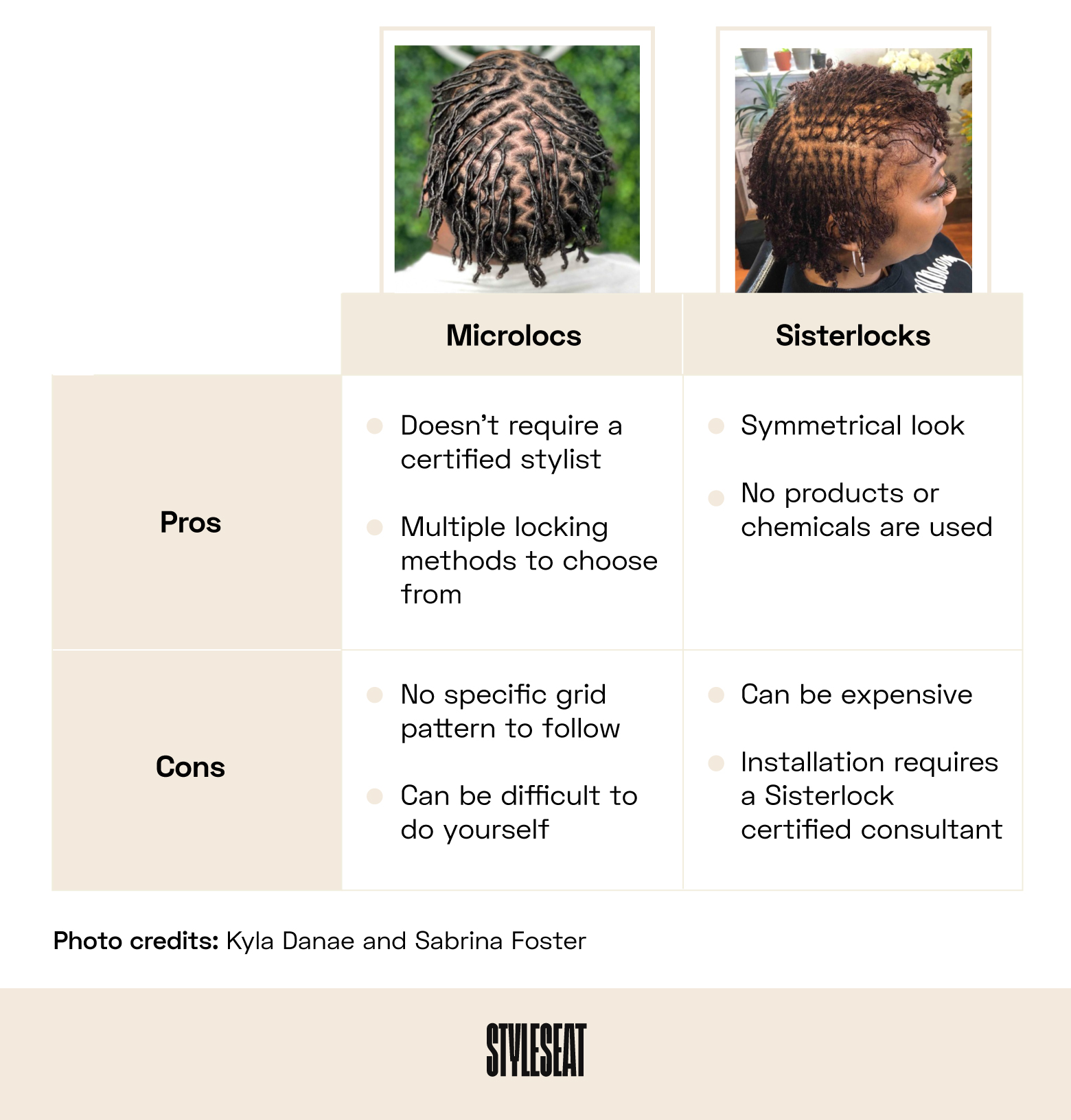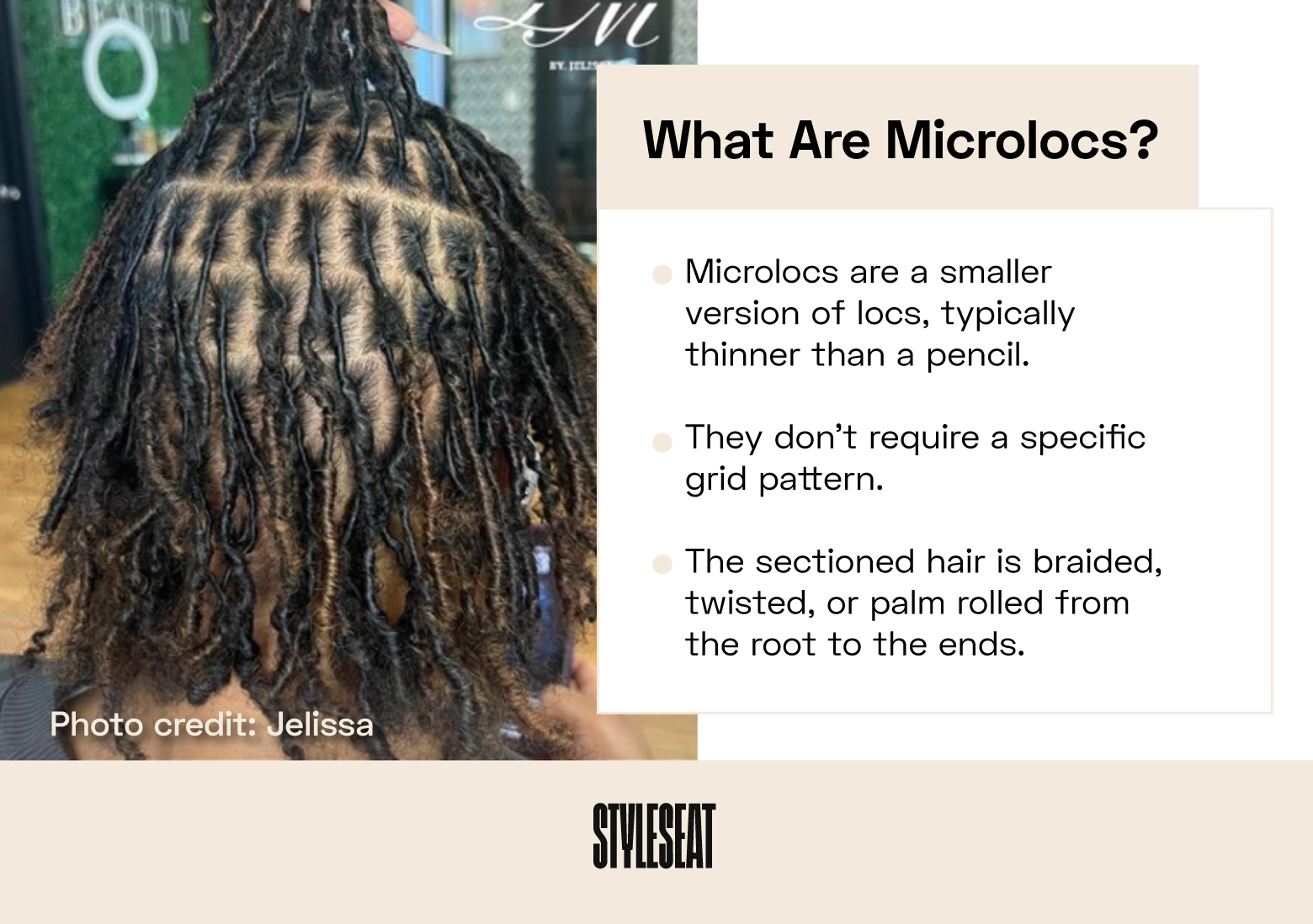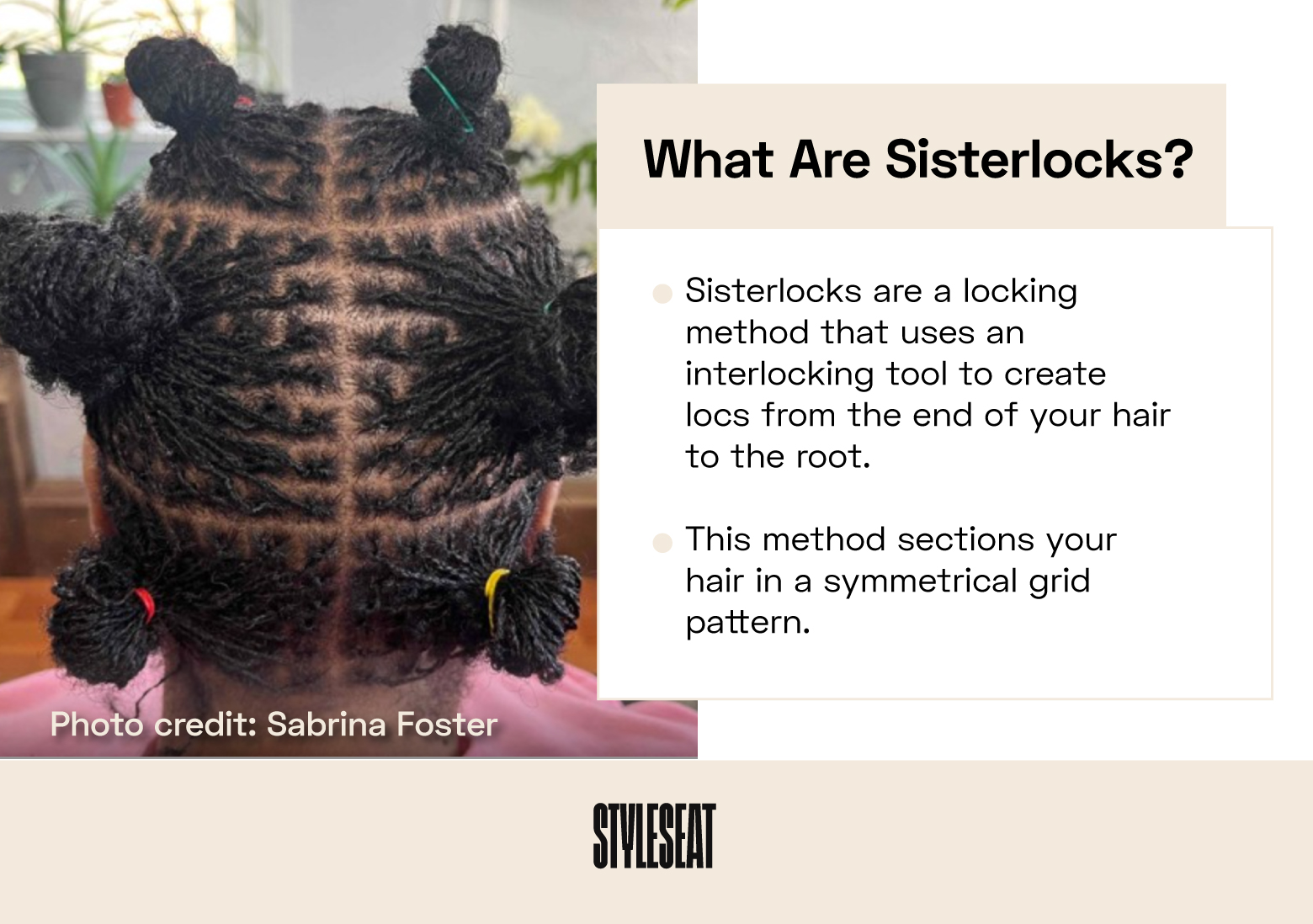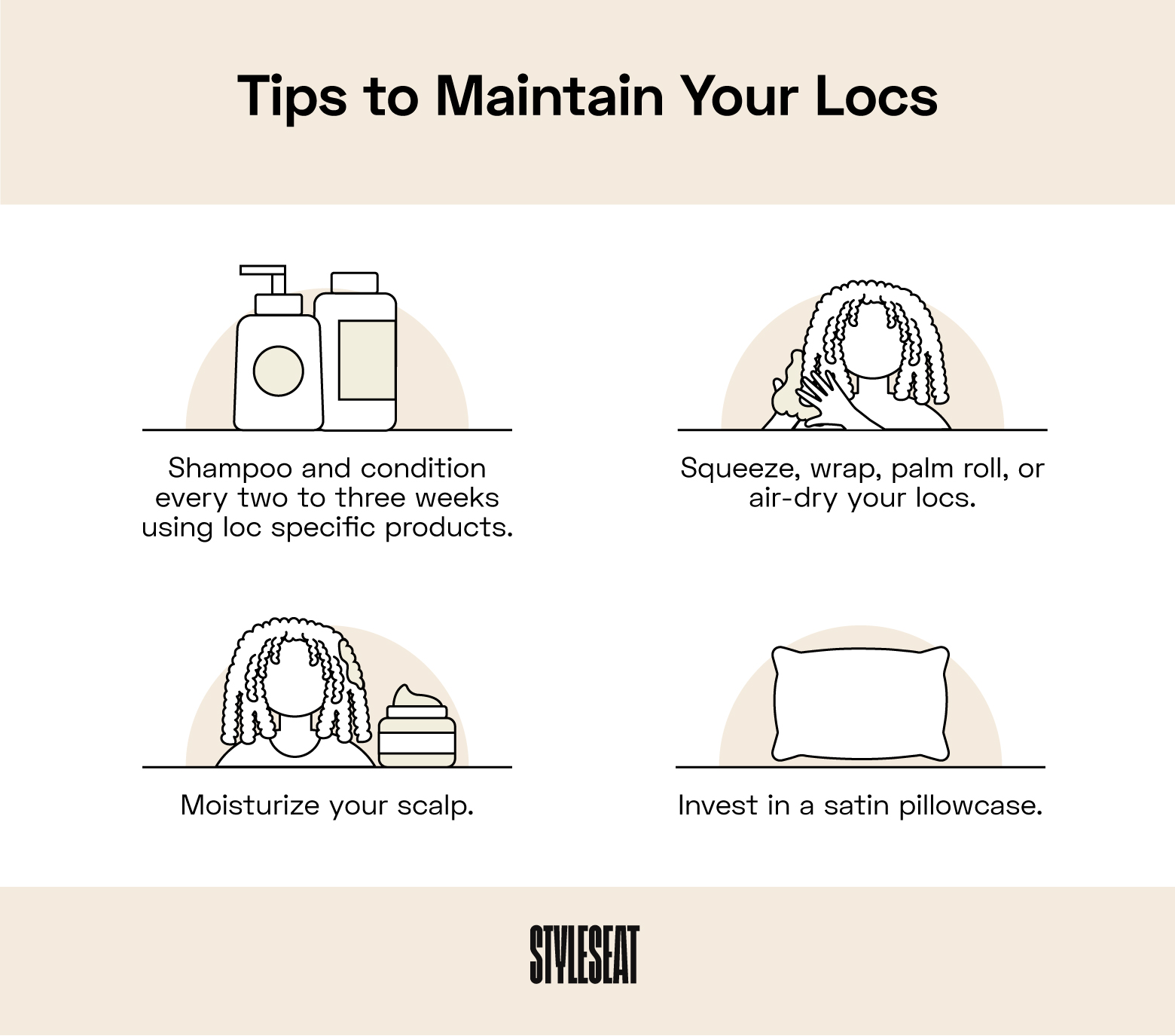You might be familiar with dreadlocks, but did you know you can get different types of dreads? Microlocs and Sisterlocks (also spelled “microlocks” and “sisterlocs,” respectively) are two variations of dreadlocks, or locs. Though they’re both versions of the same hairstyle, comparing microlocs vs. Sisterlocks illustrates more differences than similarities between these two loc styles.
Sisterlock installation uses a different technique than microlocs or traditional locs do. While microlocs, a smaller version of traditional locs, lock the hair by either twisting, rolling, coiling, or palm rolling sections of hair with loc wax, Sisterlocks are created using an interlocking tool. Microlocs can be done either at home or with a stylist, while Sisterlocks should be done by a trained Sisterlocks consultant.
To help you on your loc journey, we go over the pros and cons of microlocs vs. Sisterlocks, so you can decide on the right hairstyle for you.

What Are Microlocs?
Microlocs are a smaller version of traditional dreadlocks, typically rolled to about the size of a pencil. These locs are created by braiding, twisting, coiling, or palm rolling smaller sections of your hair from the root to the ends, then locking the hair with loc wax. While you can do it yourself, a stylist may help you more easily achieve the look you envisioned.
Microlocs installation doesn’t require you to follow a specific grid pattern, so you can get creative with a pattern that works best for your hair. They also have more versatility if you’re looking for a hairstyle with more styling options.

For any style of loc, it takes time for the locs to mature and for your hair to truly lock. There are roughly five stages of locs:
- Starter: Having starter locs means you’re at the beginning stage of your loc journey, where the hair begins to settle and grow in the hairstyle. This can last about six months.
- Budding: In the budding stage, you’ll see bumps and frizziness in your locs as they continue developing. You might also need retwisting in some areas. This stage lasts from months 6 to 12.
- Teenage: In the teenage stage, the locs may seem like they have a mind of their own, and can look a bit awkward based on your hair growth. This stage lasts from months 12 to 18.
- Mature: At this stage, your locs should have matured, meaning they’ve truly taken the form of locs and look like they’re in the right shape. This happens around months 15 to 18.
- Final: Once you’ve passed the mature stage, your locs should continue growing in their right shape from month 18 on.
What Are Sisterlocks?
Sisterlocks are a type of loc style that uses a specific interlocking technique, created and trademarked by Dr. JoAnne Cornwell in 1993. Sisterlock installation follows a specific symmetrical grid pattern and uses a special tool to build the individual locs. This popular natural hairstyle creates locs that are thinner than traditional dreads.

Certified Sisterlock consultants who are trained in the Sisterlocks method should install Sisterlocks. Similar to microlocs, Sisterlocks mature over time and will look different from the beginning to the mature phase and can take anywhere from three months to a year to settle in.
Microlocs vs. Sisterlocks
Microlocs and Sisterlocks both have their pros and cons. The right style for you depends on both factors like your hair length, hair texture, and hair type, as well as your own personal style goals. You might want to consult with a stylist for a custom quote and advice on what works for your hair.
| Microlocs | Sisterlocks | |
| Installation Cost | $500–$1,000+ | $700–$1,500+ |
| Grid Pattern | You or your stylist can choose how to section off your hair before beginning the installation. | Your stylist sections off your hair following a symmetrical grid pattern. |
| Installation Process | Your stylist can twist your hair from the root to the ends by braiding, twisting, or palm rolling and locking with loc wax. | Your stylist uses an interlocking tool to create locs from the ends of your hair to the root using a locking pattern of their choosing. |
| Length of Installation | 6–24 hours | 8–36 hours depending on your hair length and density |
| Look | Full | Neat or symmetrical |
| Maintenance | Retwisting every 4–7 weeks | Retightening every 4–6 weeks |
Sisterlocks Are Typically More Expensive
The starting cost of getting Sisterlocks ranges from $700 to $1,500, with follow-up appointments ranging from about $200 to $400 per appointment. However, the cost of getting microlocs starts at $500 to $1,000, with retwists or relocks ranging from $100 to $300.
Traditional locs, which follow a process similar to microlocs installation, can cost around $50 to $100 for consultation and follow-up appointments.
In general, costs can vary based on several factors, including:
- Loc size
- Number of locs
- Hair length and density
- Consultation, installation, and maintenance costs
Sisterlocks Use a Specific Grid and Technique
A grid pattern refers to the way the hair is parted and sectioned off to then be locked. Sisterlocks follow a symmetrical grid pattern, and the technique for locking the hair is done using an interlocking tool to build your locs by starting with the ends to the roots.
Microlocs can be done with any grid pattern and any technique, such as braiding, twisting, coiling, or palm rolling.
Your hair density and natural curl pattern help your stylist determine what locking pattern to use on your hair. If you’re getting Sisterlocks, your consultant will choose a specific locking pattern, or the direction and number of times the interlocking tool takes the tip of your hair and moves it through the root of your hair to lock it.
Both Installs Are Time-Consuming
When comparing microlocs vs. Sisterlocks, both can be time-consuming to install. If you go to a stylist to get them done, microlocs could take 6 to 24 hours and be done over the course of a day or two. But they still take a little less time to install than Sisterlocks. Because of their specific pattern, Sisterlocks can take approximately 8 to 36 hours, so they’re typically done over the course of a few days.
Both Methods Can Include Consultations, Installations, and Follow-Up Appointments
Microlocs, when installed by a stylist, and Sisterlocks typically require the following appointments:
- Consultation: In a consultation, the consultant explains the process and might install a few locs to give you an idea of the pattern or how your hair will be sectioned and locked.
- Installation: The stylist begins sectioning your hair, parting it into smaller sections, and locking your hair.
- Follow-up: Follow-up appointments help you maintain the style with retightening or retwisting.
If you do microlocs yourself, you can avoid the consultation and follow-up by maintaining your locs on your own. Since Sisterlocks can only be done by a certified consultant, they don’t really have the self-maintenance option.
Both Require Similar Maintenance
Microlocs need to be retwisted about every four to seven weeks. You may need a follow-up appointment for the maintenance, unless you did it yourself. Sisterlocks need to be retightened about every four to six weeks, and need follow-up appointments.
Which Is Right for You? Microlocs vs. Sisterlocks
Now that you’ve explored the differences between microlocs vs. Sisterlocks, you can make a decision on the right loc style for your natural hair type and style goals. If you’re not sure what kind of dreads you want, here are some things to consider:
- Get microlocs if:
- You want the option to DIY.
- You want to choose your grid pattern and locking technique.
- You want a less costly hairstyle.
- Get Sisterlocks if:
- You want a more symmetrical/neat look.
- You want a more permanent style.
- You don’t mind paying more for the hairstyle.

Tips to Maintain Your Locs
Healthy hair requires maintenance, especially for a style as intricate as dreadlocks. A specialized hair care routine can keep them looking beautiful and healthy in between follow-up appointments. Here are some key ways to take care of your locs:
- Shampoo and condition every two to three weeks using loc-specific products. Cleansing and conditioning your locs removes the buildup of sweat, oil, and dirt without dehydrating your hair. It’s important to use hair products that are specifically formulated for locs, since regular hair products can cause loosening or unraveling.
- Squeeze, wrap, palm roll, or air-dry your locs. To prevent mildew growth, it’s important to make sure your locs are completely dry after you wash them. Using these methods helps ensure you get every drop of water out of your locs. If you live in a warmer climate, letting them air-dry in the sun can also help.
- Invest in a satin pillowcase. Sleeping on a satin pillowcase can help prevent damage and breakage.
- Moisturize your scalp. Though locs can be sturdier than natural hair, they’re still prone to breakage and unraveling. In addition to sleeping on a satin pillowcase, moisturizing your scalp with a lightweight oil helps keep your locs healthy.
Your stylist or loctician might give you more detailed tips on how to maintain your locs based on your hair type and density.
Other Styles to Consider
If you like how dreadlocks look but aren’t quite sure they’re right for you, there are a lot of similar styles out there. Here some other popular braiding and twisting styles to consider:
- Faux locs: Faux locs help you get the look of dreads without the same long-term hair commitment. Your stylist can wrap synthetic extensions around braids of your natural hair, braiding or crocheting them to interlock the strands.
- Cornrow braids: Cornrows are narrow braids, braided very close to the scalp.
- Micro braids: These tiny braids resemble more of a thick strand of hair in contrast to the thickness of box braids or traditional locs.
- Fulani braids: Combining the texture of cornrows and box braids, Fulani braids are narrow braids that are typically flush against your scalp on top but transition to box braids in the back for high volume with long hair extensions.
- Senegalese twists: Senegalese twists also use a crochet method. To achieve the look, your stylist crotchets pre-twisted locks of hair into your natural braids. Some stylists might use the traditional two-strand twist to combine your natural hair with the extensions.
- Nubian twists: While Nubian twists create a type of interlocking hairstyle, the twists are much tighter, falling in a coiled pattern.
- Marley twists: Inspired by Bob Marley, these twists are bonded together using the two-strand twist method to look similar to natural locs. This style is a type of faux loc, and uses a specific kind of lightweight synthetic hair to achieve the look that’s less damaging to your natural hair.
Whether you’re at the start of your Sisterlocks journey, ready to book a traditional loc appointment, or just looking for a new protective style to try, StyleSeat has you covered. Use our search tool to find and book a hair pro near you.



